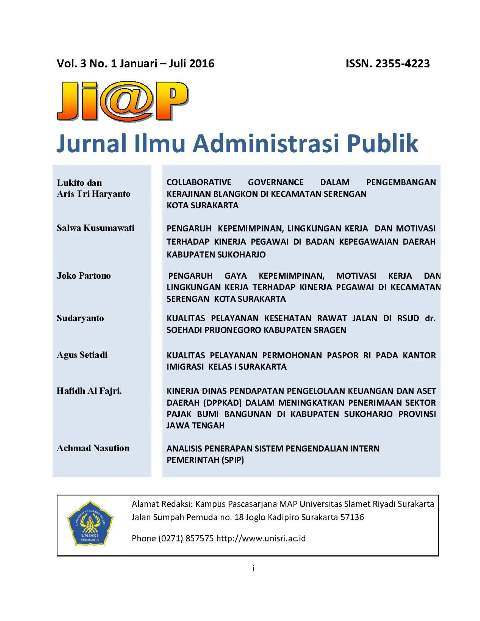ANALISIS PENERAPAN SISTEM PENGENDALIAN INTERN PEMERINTAH (SPIP)
DOI:
https://doi.org/10.33061/jp.v3i1.1201Abstract
This research aimed the application of government internal control system in
Inspectorate Office of Boyolali Regency. Five elements that were studied are: (1)
Environment of control; (2) Evaluation of risk; (3) Activity of control; Information
and communication; and (5) internal control monitoring. Case study method was
used in this study. Interview, document study, and observation data gathering
techniques were used for colleting the needed data. Validity of the finding was
supported by the data or resource triangulation method. Interactive analysis
model consisting of three elements i.e. data reduction, data display, and
verification and conclusion drawing was used to analyse the data. Research
result indicated that the application of government internal control system in
Inspectorate Office in Boyolali Regency had already implemented properly. The
data showed, however, that there were some weaknesses especially related to
infornation and communication aspect. It was found that there were no direct
accessable media such as box office, box for community suggestion,
whistleblower system, inspectorate website, and others. The success of the
application of the system depends on the ordinates commitment in particularly
and community participation in general. By doing so, good governance that is
free from collusion, corruptin, and nepotism can be realized.
Key words: Good Governance, government internal control system.
Downloads
Published
How to Cite
Issue
Section
License
Authors who publish this journal agree to the following terms:
- Authors retain copyright and grant the journal right of first publication with the work simultaneously licensed under a Creative Commons Attribution License that allows others to share the work with an acknowledgement of the work's authorship and initial publication in this journal.
- Authors can separately make additional contractual arrangements for non-exclusive distribution published by the journal (e.g., publish it in a book), with an acknowledgement of its initial publication in this journal.
- Authors are allowed and encouraged to send their work via online (e.g., in the institutional repositories or their website) after published by the journal.













